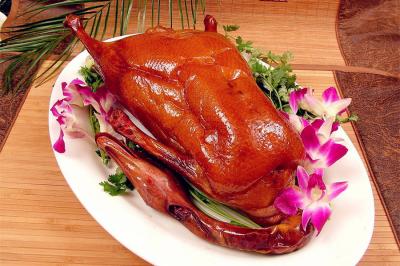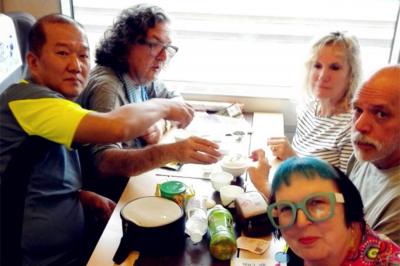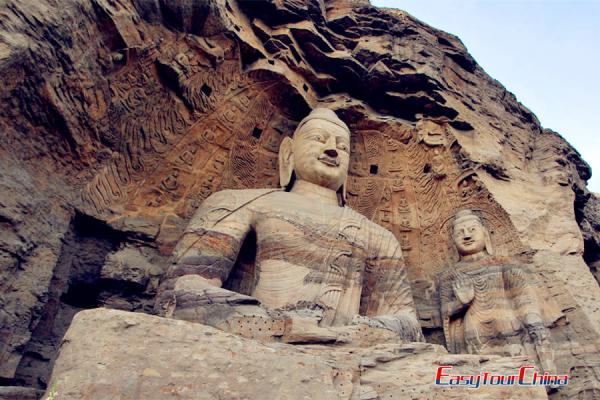Zhujiajiao Ancient Town (Zhujiajiao Water Town)
Zhujiajiao Water Town is one of the top 4 historical and cultural old towns in shanghai, and it’s a one of the famous water towns in China. Situated on the bank of the Dianshanhu Lake on the western outskirts of Shanghai, Zhujiajiao, a canal town (an enchanting place that is often compared to Venice, Italy), is about 50 kilometers away from the city center. Bridges and a river surround the town, showing the epitome of the water town of China.
There are numerous places of interest with complete leisure and activity facilities; and the natural scenery will dazzle your eyes. The town features beautiful waterways, arched stone bridges, ancient streets paved with stone; and more than 10,000 houses dating back to Ming (1368-1644) and Qing (1644-1911) dynasties. Zhujiajiao was developed into a town in the Ming Dynasty and in its prime time in 1930s, there were over 70 rice stores here and its rice was transported to many parts of the country.

After visits of participants in the Asia-Pacific Economic Cooperation meetings held in Shanghai in 2001, the town became more famous and frequented. When travel in Shanghai, visitors will be definitely fascinated by this ancient town with an exploration of the old Shanghai while marveling at the same time at Shanghai's modern life.
Zhujiajiao Water Town Facts
- RMB30 for four scenic spots (including Tongtianhe Medicine Shop, Qing Dynasty Post Office, Y-Art Gallery, and Kezhi Garden);
- RMB60 for eight scenic spots (including Y-Art Gallery, Tongtianhe Medicine Shop, Qing Dynasty Post Office, City God Temple, Yuanjin Meditation Room, Handwork Exhibition Hall, Quanhua Art Hall and Kezhi Garden);
- RMB80 for cruise boat and eight scenic spots mentioned above.
The History & Stories
The area of Zhujiajiao was formed about 7,000 years ago. Relics from the Neolithic Age to the Spring and Autumn and Warring States Periods were discovered at the bottom of Dianshan Lake. Zhujiajiao Town developed into a small market town during the Song and Yuan Dynasties and was named Zhujia Village.
In the 40th year of the Wanli reign of the Ming Dynasty (1612), due to the convenience of water transportation and the increasing prosperity of business, the Zhujiajiao competed to become a major town. It was renamed Zhu Jie Ge, also known as Zhu Li, Zhu Xi, and commonly called Jiao Li. Zhujiajiao Town, with its unique natural environment and convenient waterway transportation, is bustling with trade and continuous exchanges. It was once renowned in the Jiangnan region for its cloth industry and was known as "clothing and bedding for the world".
During the late Ming and early Qing dynasties, the rice industry in Zhujiajiao rose to prominence, driving the prosperity of various industries. The old and famous stores stand out, with department stores from the north to south streets, covering a wide range of industries.
>> Recommended Shanghai tours to Zhujiajiao
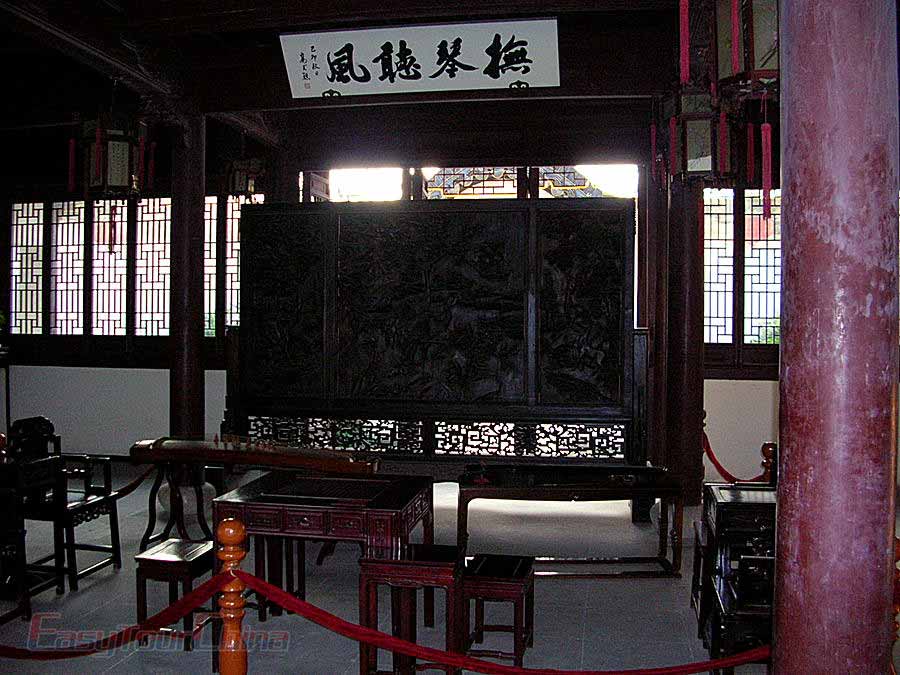
What to See in Zhujiajiao Ancient Town ?
1. Bridges
There are altogether 36 bridges in the Zhangjiajiao Water Town and each has a name and possibly a story, which will speak itself when the tourist sits on the bridge, staring at the mosses growing out of the gaps in the stones or the river on which boats pass by.
The five-arch Fangsheng Bridge built in 1571 in the Ming Dynasty is still standing there. Inscriptions on the weather-beaten steles by the side of the river tell people to do good things and accumulate merits for the after lift.
Tai 'an Bridge is 26.2 meters long, 3.2 meters wide and 4.6 meters high, spanning the Shi River, a tributary of the Caogang River. The bridge faces the ancient Yuanjin Temple. There are still two flagpole stones standing on the bridge to this day. They were originally used to hang street lamps and serve as beacons for ships passing by on the Cao Gang River.
2. Qing dynasty post office
Daqing Youju, a post office in the Qing Dynasty, was set up in 1862 and is a proof of the past importance of this small town. Letters written on bamboo and other wood, and early stamps and envelopes will leave people amazed at how fast the postal and information processes have developed.
3. Yuanjin Chanyuan
It is a temple constructed in 1341, is also worth a visit. Chenghuangmiao (City-God Temple) is a temple where Guanyin (Goddess of Mercy) is still worshipped and is popular for its Taoist faith.
4. Kezhi Garden
Like many other waterside towns in this region, Zhujiajiao has several private gardens, which used to be owned by officials or landlords but have now opened to the public. Another attraction is Kezhi Garden on Great North Street. It is one of the largest manor-style private gardens in the vast southern China region. If you like Yu Garden, and don't have time for Suzhou gardens, you will also like this one.
While strolling in the picturesque garden of this mansion, visitors can enjoy a presentation of Suzhou Pingtan, a traditional genre of artistic show, with a pair of performers singing in Suzhou dialect and playing ancient Chinese string instruments.
5. North Street
North Street is built along the river and is only 3 to 4 meters wide. It preserves the most complete architectural complex of the Ming and Qing Dynasties in the suburbs of Shanghai. Old-fashioned shop signs stand in rows, big red lanterns are hung high, and there is also the largest "Ancient Town Old Teahouse" in the suburbs of Shanghai. The shops on both sides of the street are lined with a wide variety of goods, including all kinds of handicrafts and local snacks.
>> Related reading: Most Beautiful Historical Streets in China
6. Baoguo Temple and the thousand-year-old ginkgo tree
Baoguo Temple was first built in the Ming Dynasty. Behind the temple stands an ancient ginkgo tree with a girth of 6 meters, a height of 36.5 meters, and an east-west crown diameter of 7 meters. Planted around the Five Dynasties period, over 1,050 years old, it is the oldest and largest thousand-year-old ginkgo tree in the Shanghai area and has served as a natural beacon for ships passing through Dianshan Lake over the long years.
7. Hexin Garden
Covering an area of approximately 0.3 hectares, it is a museum of gardens and history and culture. All the exhibits in the garden are original items from the Ming and Qing dynasties.
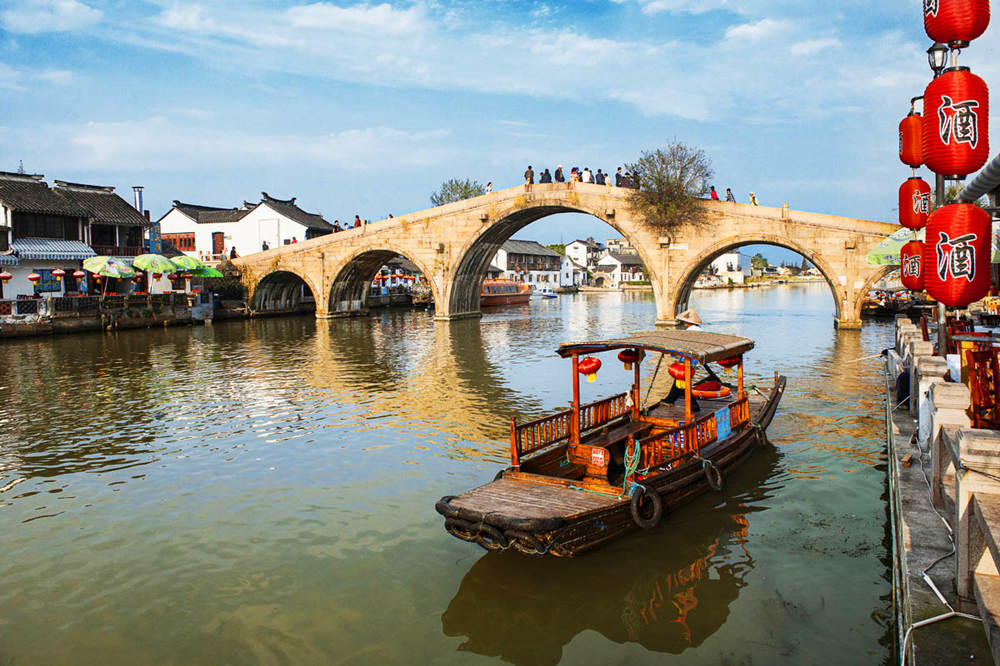
What to Do in Zhujiajiao Water Town?
1. Wander around and enjoy a relaxing time
Visitors can take a walk to explore Zhujiajiao Water Town what it looks like or board canvas-canopied boats for the canal-side Granny Tea house for a short tea break. It is the most famous teahouse in the community.
2. Zhujiajiao Water Town Boat Trip
It’s a romantic thing to lie in a boat in a Chinese water town, floating yourself on the river, going through bridges and watching them pass over you. This is a fabulous emotion of Chinese style.
3. Find delicious food in Beidajie (North Street)
North Street is one of the nine old streets of Zhujiajiao Ancient Town. It’s the best preserved here and some buildings along the street can be dated back to Qing dynasty. And now, it is home to many local specialties, snacks and typical Shanghai food which you cannot miss.
4. Experience Traditional Culture
In Zhujiajiao, you can see all kinds of "characteristic corners", such as Peking Opera corners, singing corners, literature corners, calligraphy and painting corners, etc.
The Peking Opera enthusiast organization "Yunsheng Society", established in the 1930s, is still active to this day. The singing corner is a gathering place for singing enthusiasts, who practice their voices every day in the park and at the bridgehead. The Literature Corner and the Calligraphy and Painting Corner gather a large number of literature and calligraphy and painting enthusiasts. Here, they exchange creative experiences and jointly enhance their artistic levels.
In addition, Zhujiajiao has a rich culture of book collection. The penetration rate of family book collections has reached over 50%. The total number of private books in the collection exceeds 100,000, which is ten times the total number of books in the town's cultural center.
>> Recommended best China tours to Zhujiajiao
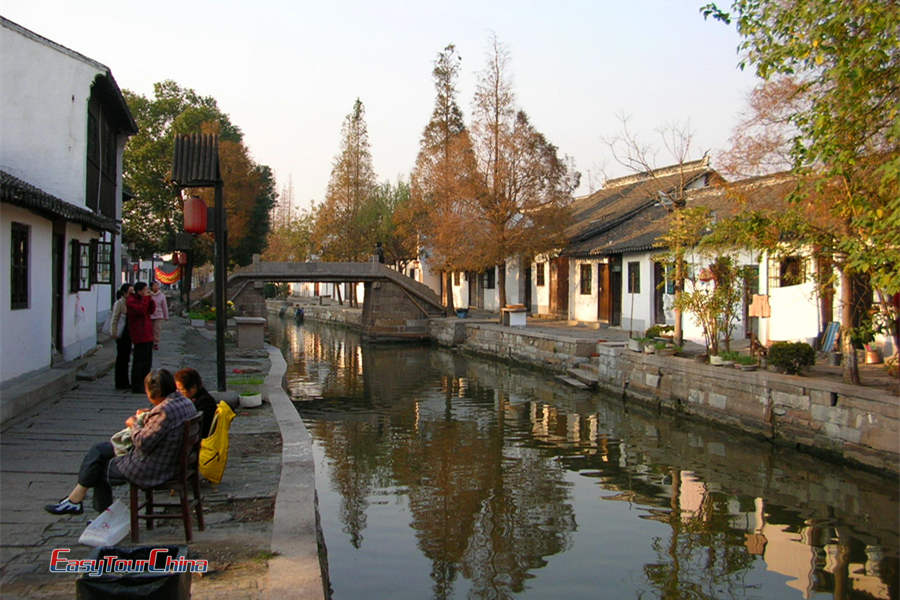
How to Get to Zhujiajiao Water Town from Shanghai?
Metro Line 17 can go straight to Zhujiajiao Station, then after you walk about 15 minutes, you can see the big greetings written on the wall in front of you.
There are a large number of Huzhu Express Lines setting off from Shanghai Tourist Center to Zhujiajiao Ancient Town. Besides, you can also a Special Line to your destination, such as Huzhu Special Line from Pu’an Road, People Square, Huzhu Special Line from West Bus Station and Shangzhu Special Line from Shanghai South Rail Station.
If you are not very familiar with Bus Station or bus stops of Shanghai, we still recommend you book a car or take taxi to Zhujiajiao, in this way, your driver can escort you safely and conveniently.
Qibao Ancient Town vs Zhujiajiao Water Town
Founded in the Song and Yuan dynasties, Zhujiajiao became a major commercial center in the Ming Dynasty due to the prosperity of water transportation. It is known as "Venice of Shanghai". Qibao is named after the "Qibao Temple" of the Song Dynasty. It retains the urban landscape of the Jiangnan region, but its historical and cultural experiences are slightly inferior to those of Zhujiajiao.
Zhujiajiao is located in Qingpu District, Shanghai, about 50 kilometers away from the city center. It is directly accessible by Metro Line 17 (Zhujiajiao Station), and it takes about 1 hour by car. Qibao is located in Minhang District. It is directly accessible by Metro Line 9's "Qibao Station" and is only a 20-minute drive from the city center.
Zhujiajiao is more suitable for a half-day or one-day tours from Shanghai, while Qibao can serve as a supplement to the Shanghai city tour.
>> Related reading: Top 10 Ancient Towns of China
More Attractions in Shanghai
